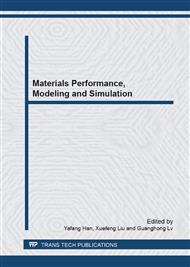[1]
Daiwei Gong, Craig A, Oomman K. Varghese, Titanium oxide nanotube arrays prepared by anodic oxidation, J. Mater. Res., 16(2001)3331-3334.
DOI: 10.1557/jmr.2001.0457
Google Scholar
[2]
G. K. Mor, Oomman K. Varghese, Craig A. Grimes, et al., Fabrication of tapered, conical-shaped titania nanotubes, J. Mater. Res., 18(2003)2588-2593.
DOI: 10.1557/jmr.2003.0362
Google Scholar
[3]
Chuanmin Ruan, Maggie Paulose, Craig A. Grimes, et al., Fabrication of highly ordered TiO2 nanotube arrays using an organic electrolyte, J. Phy. Chem. B, 109(2005)15754-15759.
DOI: 10.1021/jp052736u
Google Scholar
[4]
Gopal K. Mor, Karthik Shankar, Craig A. Grimes, et al., Enhanced photocleavage of water using titania nanotube arrays, Nano Lett., 5(2005)191-195.
DOI: 10.1021/nl048301k
Google Scholar
[5]
Jan M. Macak, Martin Zlamal, Patrik Schmuki, et al., self-organized TiO2 nanotube layers as highly efficient photocatalysts, Small, 3(2007)300-304.
DOI: 10.1002/smll.200600426
Google Scholar
[6]
Oomman K. Varghese, Dawei Gong, Craig A. Grimes, et al., Extreme changes in the electrical resistance of titania nanotubes with hydrogen exposure, Adv. Mater., 15(2003)624-627.
DOI: 10.1002/adma.200304586
Google Scholar
[7]
Gopal K. Mor, Karthik Shankar, Craig A. Grimes, et al., Use of highly-ordered TiO2 nanotube arrays in dye-sensitized solar cells, Nano Lett., 5(2006)215-218.
DOI: 10.1021/nl052099j
Google Scholar
[18]
Keat G. Ong, Oomman K, Craig A. Grimes, et al., Application of fimite-difference time domain to dye-sensitized solar cells: The effect of nanotube-array negative electrode dimensions on light absorption, Solar Enery Materials & Solar Cells, 91(2007).
DOI: 10.1016/j.solmat.2006.09.002
Google Scholar
[9]
Lixue Deng, Shurong Wang, Shoumin Zhang, et al., Synthesis, characterization of Fe-depoed TiO2 nanobubes with high photocatalytic activity, Catal. Lett., 129(2009)513-518.
DOI: 10.1007/s10562-008-9834-5
Google Scholar
[10]
Wongyong Choi, Andress Termin, Michael R. Hoffmann, The role of metal ion dopants in quantum-sized TiO2: correlation between photoreativity and carrier recombination dynamics, J. Phys. Chem. 98(1994)13669-13679.
DOI: 10.1021/j100102a038
Google Scholar
[11]
K. Wike, H.D. Breuer, The influence of transition metal doping on the physical and photocatalytic properties of titania, Journal of photochemistry and photobiology A: Chemistry, 121(1999)49-53.
DOI: 10.1016/s1010-6030(98)00452-3
Google Scholar
[12]
Lecheng Lei, Yaling Su, Minghua Zhou, et al., Fabrication of multi-non-metal-doped TiO2 nanotubes by anodization in mixed acid electrolyte, Materials Research Bulletin, 42(2007)2230-2236.
DOI: 10.1016/j.materresbull.2007.01.001
Google Scholar
[13]
Na Lu, Xie Quan, Guohua Chen, et al., Fabrication of Boron-doped TiO2 nanotube array electrode and investigation of its photoelectrochemical capability, J. Phys. Chem. C, 111(2007)11836-11842.
DOI: 10.1021/jp071359d
Google Scholar
[14]
Robert Hahn, Andrei Ghrei Ghicov, Patrik Schmuki, et al., Carbon doping of self-organized TiO2 nanotube layers by thermal acetylene treatment, Nanotechnology, 18(2007)105604-105608.
DOI: 10.1088/0957-4484/18/10/105604
Google Scholar
[15]
Takeshi Morikawa, Ryoji Asahi, Takeshi Ohwaki, et al., Band-gap narrowing of Titanium dioxide by nitrogen doping, Jpn. J. Appl. Phys. 40(2001)L561-L563.
DOI: 10.1143/jjap.40.l561
Google Scholar
[16]
R. Asahi, T. Morikawa, T. Ohwaki, et al., Visible-light photocatalysis in nitrogen-doped titanium oxides, Science, 293(2001)269-271.
DOI: 10.1126/science.1061051
Google Scholar
[17]
Karthik Shankar, Kong Chhay Tep, Craig A Grimes, et al., An electrochemical strategy to incorporate nitrogen in nanostructured TiO2 thin films: modification of bandgap and photoelectrochemical properties, J. Phys. D: Appl. Phys., 39(2006).
DOI: 10.1088/0022-3727/39/11/008
Google Scholar
[18]
R. P. Vitiello, J. M. Macak. P. Schmuki, et al., N-doping of anodic TiO2 nanotubes using heat treatment in ammonia, Electrochemistry Communications, 8(2006)544-548.
DOI: 10.1016/j.elecom.2006.01.023
Google Scholar
[19]
J. M. Macak, A. Ghicov, R. Hahn, P. Schmuki, et al., Photoelectrochemical properties of N-doped self-organized titania nanotube layers with different thicknesses, J. Mater. Res., 21(2006)2824-2828.
DOI: 10.1557/jmr.2006.0344
Google Scholar
[20]
Andrei Ghicov, Jan M. Macak, Patrik Schmuki, et al., TiO2 nanotube layers: Dose effets during nitrogen doping by ion implantation, Chemical Physicals Letters, 419(2006)426-429.
DOI: 10.1016/j.cplett.2005.11.102
Google Scholar
[21]
Andrei Ghicov, Jan M. Macak, Patrik Schmuki, et al., Ion implantation and annealing for an efficient N-doping of TiO2 nanotubes, Nano Lett., 6(2006)1080-1082.
DOI: 10.1021/nl0600979
Google Scholar
[22]
Doohun Kim, Shinji Fujimoto, Hiroaki Tsuchiya, et al., Nitrogen doped anodic TiO2 nanotubes grown from nitrogen-containing Ti alloys, Electrochemistry Communications, 10(2008)910-913.
DOI: 10.1016/j.elecom.2008.04.001
Google Scholar
[23]
Dong Fang, Kelong Huang, Suqin Liu, et al., High-density NiTiO3/TiO2 nanotubes synthesized through sol-gel method using wll-ordered TiO2 membranes as template, Journal of alloys and Compunds, 498(2010)37-41.
DOI: 10.1016/j.jallcom.2010.02.150
Google Scholar
[24]
Zhonghai Zhang, Md Faruk Hossain, Takakazu Takahashi, Photoelectrochemical water splitting on highly smooth and ordered TiO2 nanotube arrays for hydrogen generation, Internationa Journal of Hydrogen energy, 35(2010)8528-8535.
DOI: 10.1016/j.ijhydene.2010.03.032
Google Scholar
[25]
Yeonmi Shin and Seonghoon Lee, Self-orgnized regular arrays of anodic TiO2 nanotubes, Nano Lett., 8(2008)3171-3173.
DOI: 10.1021/nl801422w
Google Scholar
[26]
Daoai Wang, Feng Zhou, Weimin Liu, A novel protovol toward perfect alignment of anodized TiO2 nanotube, Adv. Mater., 212(2009)1964-(1967).
Google Scholar
[27]
Chiatzun Goh, Kevin Coakley, Michael D. McGehee, Nanostructuring titania by embossing with polymer molds made from anodic alumina templates, Nano Lett., 5(2005)1545-1549.
DOI: 10.1021/nl050704c
Google Scholar
[28]
Yuekun Lai, Changjian Lin, Jianying Huang, Markedly controllable adhesion of superhydrophobic Spongelike Nanostruture TiO2 Films, Langmuir, 24(2008)3867-3873.
DOI: 10.1021/la7031863
Google Scholar
[29]
Amy L. Linsebigler, Guangquan Lu, John T. Yates, Photocatalysis on TiO2 surface: principles, mechanisms, and sekected results. Chem. Rev, 95(1995)735-758.
DOI: 10.1021/cr00035a013
Google Scholar
[30]
Karthik Shankar, James I. Basham, Craig A. Grimes, et al., Recent advances in the use of TiO2 nanotube and nanowire arrays for oxidative photoelectrochemistry, J. Phys. Chem. C, 113(2009)6327-6359.
DOI: 10.1021/jp809385x
Google Scholar
[31]
Naresh C. Saha, Harland G. Tompkins, Titanium nitride oxidation chemistry: An X-ray photoeledtron spectroscopy study, J. Appl. Phys., 72(1992)3072-3079.
DOI: 10.1063/1.351465
Google Scholar


